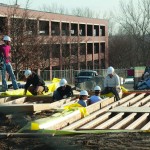Studio 804 construction moves forward
By Jon Parton
Construction of Galileo’s Pavilion is progressing rapidly, with the expectation of opening the college’s newest building in time for the fall 2012 semester.
The building is a collaborative effort between the college’s Center for Sustainability and Studio 804, a graduate architecture program at the University of Kansas.
The design of the building emphasizes a style of architecture that promotes energy efficiency and uses a large amount of refurbished material in its construction.
The goal of the project is to design a building that conforms to Leadership in Energy and Environmental Design (LEED) ratings system created by the United States Green Building Council, a non-profit trade organization. LEED ratings are used to effectively measure green building operation and construction, according to Kim Criner, Sustainability student affairs coordinator.
“It’s a national standard for which to strive, to build buildings the most energy efficient way possible,” Criner said.
LEED rated buildings can qualify for four levels of certification; Certified, Silver, Gold, and Platinum. Criner believes it is important for the college to achieve a Platinum rating.
“Buildings in this country use the majority of electricity that we use. If we can make them more efficient and better at using electricity, then we can cut that down,” Criner said.

The LEED ratings process begins at the start, making sure builders use refurbished and recycled materials to build with.
“It looks at the entire construction process, not just the finished building,” Criner said.
Jay Antle, executive director, Sustainability Center, said he believes that LEED certified buildings benefit the environment and the people that use them.
“They’re healthier workplaces, they’re healthier classrooms,” Antle said.
In addition to the energy costs the college stands to save, Antle said he also enjoys the practical use of Galileo’s Pavilion.
“We certainly need classroom space on this campus,” Antle said.
With budgetary shortfalls continually dogging the college, some people have addressed concerns regarding the cost of the new building. According to Kevin Clark, student chair, Sustainability, reducing costs to the college is the reason why it is being built.
“It can be more expensive to build initially but in the long-term, the buildings pay themselves back through energy costs,” Clark said.
The process of creating a LEED Platinum-rated building is more involved, according to Clark. Construction materials have to be examined by the Green Building Certification Institute, which report their findings to help determine a building’s rating.
“A LEED certified building is essentially architecture made for sustainability,
Clark said. “Documentation is a big part of that.” C
Studio 804 is contributing to the construction effort in order to help minimize cost for the college. Clark said a successful example of a LEED rated building is the Olathe Healthcare Education Center, which recently scored a Gold rating.
“The Olathe Healthcare Education Center came in a million dollars under budget,” Clark said.
Contact Jon Parton, staff reporter, at [email protected].






















[…] and conforms to LEED (Leadership in Energy and Environmental Design) Platinum standards (see Galileo Pavilion on schedule for fall 2012 completion for more […]